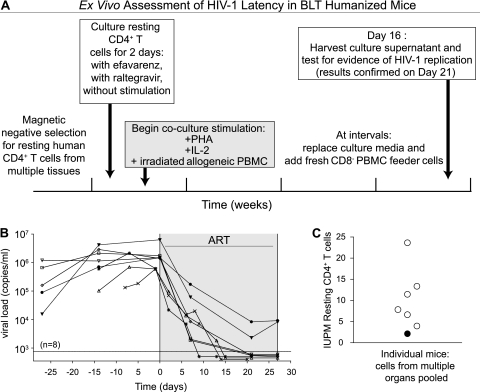Fig 3.
Latent HIV infection occurs in BLT mouse resting human CD4+ T cells. (A) The ex vivo assessment of HIV-1 latency in humanized BLT mice is depicted. Daily ART dosing consisted of FTC, TDF, and raltegravir. PHA, phytohemagglutinin; IL-2, interleukin 2; PBMC, peripheral blood mononuclear cells. (B) Plasma viral loads from eight infected BLT mice were followed pre- and post-ART initiation, and then mice were harvested between days 20 and 27 of ART. Day 0 corresponds to the time at which ART was initiated, and days during ART are shaded gray. (C) At harvest, resting CD4+ T cells were isolated from the pooled cells from individual mice and then placed into coculture according to clinical protocols to determine the frequency of latently infected cells in each animal during ART. Outgrowth assay determinations of IUPM resting CD4+ T cells from six animals with nondetectable viral loads at harvest are plotted as open circles, while one mouse with detectable viral load at harvest is represented with a filled circle. The second mouse with detectable viral loads at harvest is not represented in the graph, due to an unusually low yield of resting CD4+ T cells.

